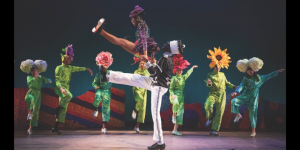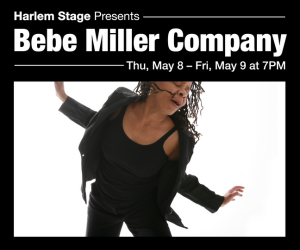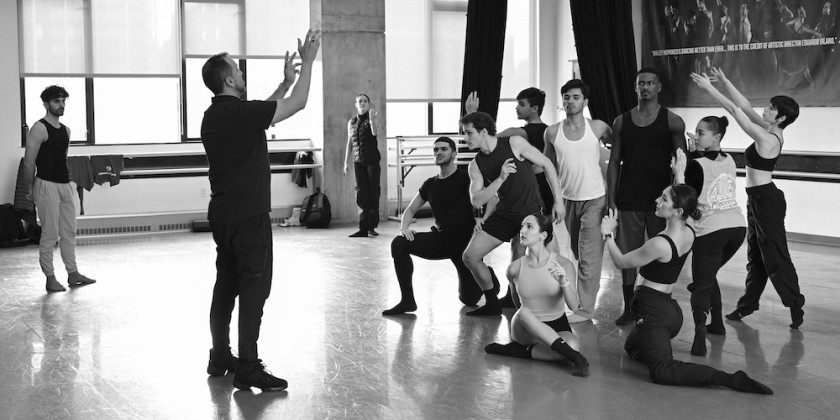IMPRESSIONS: Matthew Bourne/New Adventures’ "The Red Shoes" at New York City Center

Sunday, October 29, 2017 at 2 p.m.
Based on the film by Michael Powell and Emeric Pressburger and the Hans Christian Andersen fairytale
Direction and Choreography: Matthew Bourne
Projection Design: Duncan McLean
Lighting Design: Paule Constable
Set and Costume Design: Lez Brotherston
Performance: New Adventures with guest artists
Performances run through November 5. For tickets, go to New York City Center.
Pictured above: Marcelo Gomes as Julian Craster and Sara Mearns as Victoria Page in Matthew Bourne's The Red Shoes
Before Black Swan, The Red Shoes depicted the destructive all-consuming nature of ballet. I didn’t see The Red Shoes (1948) until I was an adult when the do-or-die mentality that embroidered my dancing had long since frayed. Yet the story still resonated. Ballet can exert an obsessive allure, convincing its devotees to sacrifice themselves on its tulle-covered altar in pursuit of a perfection that will never happen. It’s dark indeed outside the spotlight.
Sir Matthew Bourne saw The Red Shoes as a teenager, and it left an indelible imprint. On his bucket list for twenty years, he brought the story to the stage in 2016. His production premiered to sold-out runs in London and recently landed at New York City Center.
Bourne has earned acclaim for his populist renderings of classics that take risks (male swans, a vampire hero) but still flaunt big-theater spectacle. The Red Shoes is no exception, offering plenty of 1940s pizzazz that shows ticket buyers where their money went.
Like most translations of words into movement, the story has been streamlined. Two men vie for the affection of Vicky Page, a gifted dancer. Impresario Boris Lermontov (stern-jawed Sam Archer, who smolders like a soap opera star) can provide Vicky with plum parts and adulation. Bespectacled Julian Craster, a struggling composer, has only himself to offer. Vicky chooses love over art until a pair of red pointe shoes beckons temptingly. Like the protagonist in Hans Christian Andersen’s tale, Vicky succumbs to the slippers’ sinister spell — dance till you die! Overwrought, she dashes headfirst into a throttling train, free, finally, from the societal strictures that force a woman to choose between her on- and off-stage passions.

Bourne manifests this tension in the set, a glinting proscenium arch that can be rotated 180 degrees. On one side, backswept curtains of crimson showcase dance numbers, including a ballet within the ballet — a short, dystopian portrayal of Andersen’s fairytale. When the set turns, the drapes hang limply, colored the dull gray of backstage where interpersonal drama rivals the onstage shenanigans.
Bourne’s undistinguished, ballet-lite choreography looks like it was created by committee. It swirls, it twirls, and it whirls, in dizzying chains of waltzy turns. Arms flutter in fussy port de bras while torsos balloon with emotion. The movement palette pulls from styles like tango, lindy, and vaudeville, but Bourne constructs sequences so broad and garish that these inclusions feel rote rather than inspired.
If the choreography underwhelms, then the music overwhelms. Stitched together from the oeuvre by Bernard Herrmann, the composer who scored the iconic films of Alfred Hitchcock, the numbers bellow with ostentatious peaks and valleys. The symphonic swells and bleats demand emotional responses: joy when Vicky and Julian kiss, sympathy for Lermontov as he watches, and alarm when Lermontov conveys his displeasure at discovering a rival.

New York audiences can catch several casts, most tantalizingly Sara Mearns (principal at New York City Ballet) as Vicky and Marcelo Gomes (principal at American Ballet Theatre) as Julian. Mearns brings gravitas to a paper-thin role that doesn’t suit her silky athleticism. Gomes doesn’t fare as well. He’s too cool, too cerebral to convincingly portray the awkward, hot-blooded composer. Their pairing, however, appears a win/win for marketing. Audiences witness two beloved stars dancing together while Mearns and Gomes can amplify their brands.
As a critic, Bourne’s The Red Shoes is everything I wanted it not to be: campy, flimsy, busy, less a ballet and more a piece of Broadway cheese where sunny clichés eclipse the darker tones. The ending, even if you know it’s coming, chugs out of nowhere as Vicky’s desperate desire to dance functions as a plot point rather than a deeply realized character trait.
As an audience member, Bourne’s The Red Shoes is everything I didn’t know I wanted: humorous, energetic, filled with heart, neither a mean nor a snarky nor an impenetrable moment in its two-hour run time. For all its failures to manifest the pathos of the film, The Red Shoes succeeds like a cliché. Under a surface well polished by continual recitation lurks the truth — dance is the most demanding, retaliatory lover of all.















